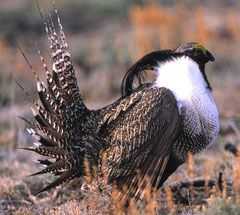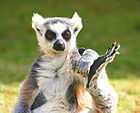Gunnison grouse
| Gunnison sage-grouse | |
|---|---|
 | |
| Conservation status | |
| Scientific classification | |
| Kingdom: | Animalia |
| Phylum: | Chordata |
| Class: | Aves |
| Order: | Galliformes |
| Family: | Phasianidae |
| Subfamily: | Tetraoninae |
| Genus: | Centrocercus |
| Species: | C. minimus |
| Binomial name | |
| Centrocercus minimus Young et al., 2000 | |
The Gunnison sage-grouse (Centrocercus minimus) is a species of grouse endemic to the United States. It is similar to the closely related greater sage-grouse (Centrocercus urophasianus) in appearance but about a third smaller in size, with much thicker plumes behind the head; it also has a less elaborate courtship dance. It is restricted in range to southwestern Colorado and extreme southeastern Utah, with the largest population residing in the Gunnison Basin region in Colorado. Despite being native to a country where the avifauna generally is relatively well known, it was overlooked until the 1990s due the similarities with the sage grouse, and only described as a new species in 2000—making it the first new avian species to be described from the USA since the 19th century.[2] The description of C. minimus as a separate species is supported by a molecular study of genetic variation, showing that gene flow between the large-bodied and the small-bodied birds is absent.[3]
Gunnison sage-grouse are notable for their elaborate courtship rituals. Each spring males congregate on leks and perform a "strutting display". Groups of females observe these displays and select the most attractive males to mate with. Only a few males do most of the breeding. Males perform on leks for several hours in the early morning and evening during the spring months. Leks are generally open areas adjacent to dense sagebrush stands, and the same lek may be used by grouse for decades.
The numbers of this species are declining due to loss of habitat; their range has shrunk in historical times. Following petitions the species has been proposed for listing under the Endangered Species Act, by the United States Fish and Wildlife Service.[4]
Distribution
Gunnison sage-grouse occur in seven counties in southwestern Colorado and 1 county in southeastern Utah.
Timing of major life events
Males gather on the lek or strutting grounds, which are small open areas where breeding occurs, in late February to April, as soon as the lek is relatively free of snow. Only a few dominant males, usually 2, breed. After mating, the hen leaves the lek for the nesting grounds. Clutch size ranges from 6 to 8 eggs; incubation time is 25 to 27 days. sage-grouse apparently have high rates of nest desertion and nest predation.[5]
Preferred habitat
Gunnison sage-grouse are totally dependent on sagebrush-dominated habitats. Sagebrush is a crucial component of their diet year-round, and sage-grouse select sagebrush almost exclusively for cover.
References
![]() This article incorporates public domain material from the United States Department of Agriculture document "Centrocercus minimus".
This article incorporates public domain material from the United States Department of Agriculture document "Centrocercus minimus".
- ↑ BirdLife International (2012). "Centrocercus minimus". IUCN Red List of Threatened Species. Version 2013.2. International Union for Conservation of Nature. Retrieved 26 November 2013.
- ↑ Young, J.R., C.E. Braun, S.J. Oyler-McCance, J.W. Hupp, & T.W. Quinn (2000). "A new species of sage-grouse (Phasianidae: Centrocercus) from southwestern Colorado". Wilson Bulletin 112 (4): 445–453. doi:10.1676/0043-5643(2000)112[0445:ANSOSG]2.0.CO;2.
- ↑ Kahn NW, Braun CE, Young JR, Wood S, Mata DR, Quinn TW (1999). "Molecular analysis of genetic variation among large- and small-bodied Sage Grouse using mitochondrial control region sequences". The Auk 116 (3): 819–824. doi:10.2307/4089344.
- ↑ Gunnison Sage-grouse. Western State Colorado University (2013)
- ↑ Johnsgard, Paul A. (1973). Grouse and quails of North America. Lincoln, NE: University of Nebraska Press ISBN 0803208103.
| ||||||||||||||||||||||||||||||||||||||||||||||||||||

